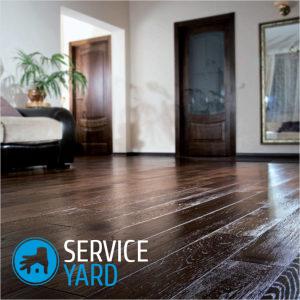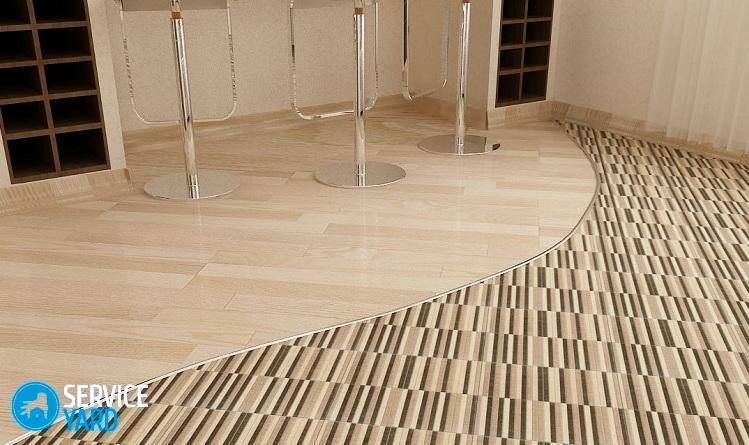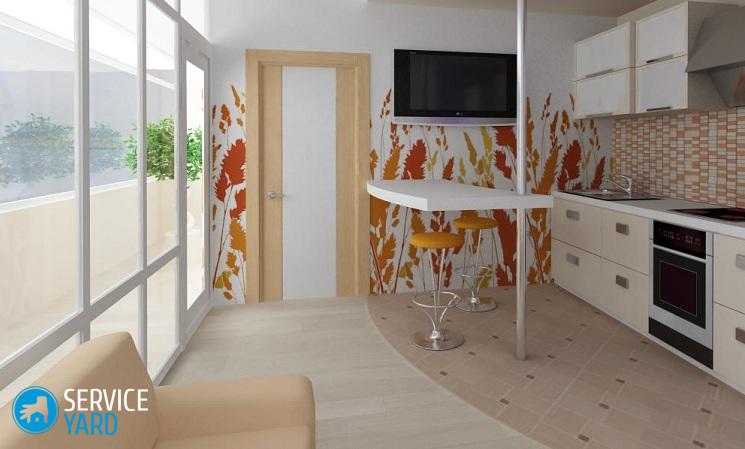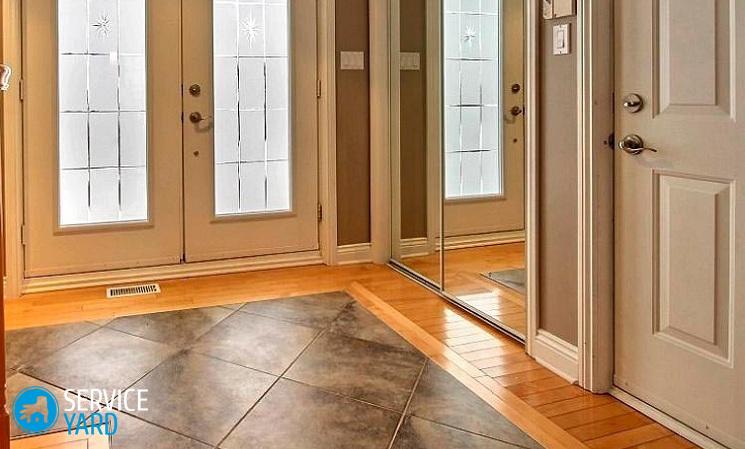Tile and laminate flooring design

When repairs begin in your home, sooner or later you will be faced with the question of choosing flooring in the premises. There are a lot of options for building material for the floor - it can be traditional linoleum, chic parquet, ceramic tiles, new-fashioned laminate. Of course, this also depends on the type of room, its purpose. We would like to draw your attention to these two materials: tile and laminate. These are affordable and practical coatings that are universal in nature, suitable for almost all rooms, and look more than impressive. Let's look at the design of tile and laminate floors in more detail.
to contents ↑What is laminate flooring?
You should start by exploring this building material. Designers consider the laminate to be an excellent floor finish, because it gives the rooms coziness and warmth, and the appearance of the floor becomes stylish, elegant. Even stylists respect him for a high degree of decorativeness: an incredible number of textures, colors allows you to realize any idea of interior design, while subtly, gracefully combining the cover with furniture and the color performance of the situation as a whole.
Device
Laminate consists of four layers:
- Moisture resistant. This property is achieved through a special film that effectively protects the canvas from moisture.
- Tiles made of chipboard or fiberboard.
- Decorative. It is on it that a drawing imitating a tree is applied.
- Lamination film. With its help, the board acquires a smooth surface, as well as resistance to various kinds of loads and environments.
Important! In the process of high-tech process, all layers of the laminate are connected under the influence of high pressure, temperature.
Benefits
If you still doubt whether to use such material, then we can say with confidence that the laminate and interior design are excellent companions. And all thanks to its countless advantages:
- The optimum degree of water resistance of the coating. Two extreme layers of the board perfectly protect the wood core from moisture. And additional preservation is given by special impregnation with resins.
Important! Compared to parquet, the laminate is more resistant to water. Although we all provoke profuse wetting of the coating is not recommended.
- Strength and wear resistance. The rigid base of the laminate and its surface are amazingly resistant to mechanical damage, whether it is impacts from falling objects or scratches from wheels and legs of furniture - the coating will be like new. This material is not afraid of the pressure of heavy objects - it will not sell, will not change shape. Although it is still not worthwhile to specifically conduct experiments and provoke damage to the material.
Important! Laminate is resistant to ignition.
- Easy maintenance of the laminated board. Simple stains from juice or tea, as well as more complex traces of markers, even nail polish, can easily be removed from the floor surface. To wipe such a floor is a pleasure.
- Laminate is not subject to sunlight. Even after a long time, the color palette of the floor finish will remain unchanged.
- Installation of building materials. The process of laying the board is quite simple, and you can certainly do it yourself.Installing the boards end-to-end with each other will not require after any additional processing procedures: neither grinding, nor scoring, which are necessary for parquet.
- Universality. This finishing material for the floor can be applied in any rooms and stylistic directions of the interior.
And, of course, another spectacular advantage of the laminate is its appearance. The board perfectly imitates all kinds of wood so that you can not immediately distinguish it from parquet. There are also textures of stone, even leather or other exotic materials.
Types of Laminate
The design of the laminate is largely determined by its variety. Depending on the appearance, these types of boards are distinguished:
- Single lane. Outwardly, this material is similar to a natural solid wood. Some manufacturers, to enhance this effect, make a beveled edge at the boards, the so-called bevel. This type of laminate has the power to visually increase the space of a room, to give it an elegant flavor.
- Two-way. The surface of each board of such a finish consists of two stripes, which are components of a single pattern. The coating image resembles a large format parquet.
Important! Chamfer for this type of laminate is not used.
- Three-way. High-quality imitation of a parquet board in the form of deck laying. The chamfer on this laminate is also not applied. A three-strip laminated board is represented by a wide selection of expensive and noble shades.
- Tiled laminate design. Outwardly, this material is very difficult to distinguish from real ceramics. A fabric is made in the form and size of the tile, and in addition, the quality of the cladding texture is transmitted. The roughness of the surface creates a 100% sensation of natural tile, and along its perimeter, manufacturers make a special strip that reproduces the joint seams between the tiles.
- Design material. This laminate is characterized by an exclusive and sometimes extravagant performance. There is no limit for imagination! Bright non-standard colors, patterns and ornaments, an incredible mother of pearl or pebble floor underfoot - all this allows you to realize just this kind of coating.
Important! The surface of the laminate can still be characterized by such subspecies: smooth or embossed, glossy or matte, oily or waxed.
The above types of coating are in perfect harmony with the interiors of a wide variety of styles.
to contents ↑Ceramic tile: its types and advantages
Since our design of tile and laminate floors involves the use of two materials, we will now dwell in more detail on tiles. What is this type of building decoration? Ceramics is essentially a burnt mixture of several components: sand, clay, various minerals. The surface of the tile can be coated with a special glaze or not.
Types of ceramic coating
Tile, like laminate, has a number of types:
- Porcelain tile. This type of material is highly resistant to mechanical stress, so it is most suitable for flooring. The surface of the tile is not processed with glaze.
- Majolica. This material in the process of technological production is subjected to double firing, which enhances its resistance to acids, humidity, alkalis.
Important! This type of ceramic tile is used for wall cladding in various rooms: kitchen, bathroom, hallway
- Clinker. This tile has a compacted base, which was subjected to a one-time firing under the influence of high temperatures. During processing, the material acquires a high degree of strength, is the most wear-resistant type of tile in all respects: it does not scratch, does not wear out, is not afraid of chemical, aggressive substances, moisture.
Important! Clinker is used in the design of floors, swimming pools, stairs.
- Cotto.Tile is characterized by the porous structure of the material, the basis of which is red clay. In most cases, the surface of the tile is not coated with enamel.
Important! This type is used as a flooring, has natural terracotta tones: red, yellow, pink, brown.
- Porcelain tile. What is the difference between this species and others? This is the most moisture resistant material, the absorption of which is close to zero percent. Tile also has a high level of frost resistance, so it is suitable for external decoration. It is successfully used for wall and floor cladding.
Important! The strength of the tile is so high that it is comparable to natural stone - granite, from which it got its name.
Ceramic tiles are used everywhere: in homes, in shopping centers, shops, indoors and outdoors. This popularity is due to the huge number of positive qualities of the material.
Tile Advantages
The design of the tile floors guarantees you a high-quality coating, thanks to the following material advantages:
- The naturalness of the product. Ceramics are made from clay, which is fired at high temperatures.
- Hypoallergenic tile. It is completely safe for humans and does not cause allergies.
- Hygiene This property is especially important for facing surfaces, as it eliminates the possibility of the appearance of harmful fungi and bacteria, as well as their reproduction in the room.
- Thermal conductivity. The tile has a sufficient degree of this indicator, therefore it is effectively used when installing a system of underfloor heating.
- Fire resistance. High temperature and open fire are not terrible for tiles. In emergency cases, the tile does not emit toxic substances and smoke.
Important! The tile can serve as a decorative finish for a luxurious fireplace.
- Remarkable wear resistance: the material does not scratch, does not deform, does not bend, is not afraid of chemical attack, and is not affected by ultraviolet radiation. Ceramics can withstand any load, so it is laid even on the floor in the garage.
- Huge service life. Ceramic tiles with a high class of wear resistance can serve as a floor covering for about 40-50 years, and even more in wall decoration.
- Moisture resistance. The impact of water and moisture does not have a negative effect on the tile, and therefore this material is most suitable for the bathroom, kitchen, swimming pools.
- Easy to clean and care.
- Decorativeness. A wide selection of colors of tiles, its texture, sizes, directions and patterns makes it possible to decorate the interior of any room in the most unimaginable style.
Combining floor materials: an effective solution
It would seem, why complicate the repair process with such a solution? But believe me, such a flooring looks incredibly beautiful and individual, so your home will become an exclusive work of art in terms of interior design.
The design of floors made of tiles and laminate is the most optimal and popular way of combining materials, since they are in perfect harmony in their physical properties.
Features of the combination of tiles and laminate
If you decide to combine two types of flooring, then consider the following principles:
- A careful approach to the selection of materials that should be in harmony with each other in design, texture and color.
- Reliable and aesthetic line of junction of tiles and laminate.
- Combined flooring is best used in spacious rooms.
- Such a design move is best implemented in the following rooms: kitchen, living room, hallway, bathroom and, if any, attic.
- The tile is laid in the zone of the highest load on the floor, and the laminate in the smaller one.
Tiles and laminate in the kitchen
Design of floors from tiles and laminate in the kitchen is most often performed in this version:
- The working part, in which the cooking process takes place, is covered with ceramic tiles.
- The flooring of the dining area is equipped with a laminate.
Important! The meaning of such a kitchen design is the functional zoning of space.
Practical tiles will help the housewife maintain cleanliness in the working part of the kitchen, and a cozy laminate will create a warm family atmosphere in the dining area and give everyone a sense of comfort.
Important! The combination of two materials is justified if the area of the kitchen has enough space, in a small room you should not use such an arrangement.
Floor hallway made of tiles and laminate
An important feature of the flooring in the hall is its constant exposure to high loads. Therefore, the floor must be as durable as possible. The design of the floors of tiles and laminate in the hallway is always carried out in this way:
- A more durable material, that is, ceramic tile, is laid at the threshold.
- In the rest of the room, a laminated board will already be justified.
And of course, pay special attention to the connecting line.
Living room and combination of materials
Laminate for this living space is very popular, it is used quite often. But still, the floor must be easy to clean, strong enough and preferably not slippery. That is precisely why tile can be used in combination with laminate.
The laminated board in the living room should be a middle class load.
Important! Give preference to glossy surfaces of material which visually expand the room.
The best area for laying ceramics in the living room will be:
- Places most prone to pollution.
- Dining area, if available.
The idea of combining materials is very original and can transform the interior, make it more elegant and stylish.
to contents ↑Floor color and interior design
In addition to choosing the floor finish and its type, the choice of the shade of the coating is also a difficulty. Dark tones have several advantages, these are:
- Contrast with light walls.
- Universal background for furnishing a room.
- The versatility of stylistic designs.
But on the other hand, the design of a room with a light laminate deserves no less attention. The floor of these shades gives the room lightness and airiness. In addition, this finish is now in trend and popular among designers:
- The universal light floor fits perfectly into the most diverse styles: Provence, Minimalism, Loft, Modern. And if the surface sparkles with gloss, then this is an attribute of the hi-tech Hi-Tech trend.
- Light shades of laminate and tiles can be presented both in pleasant pastel shades, a beige-brown palette, and modern fashionable colors: bleached oak, pine, ash.
Important! One of the rules for room design is the combination of the color of the flooring and interior doors.
But as in many other cases, designers like exceptions and allow you to create vivid contrasts and accents in the interior. For instance:
- The dark floor looks spectacular surrounded by light walls and doors. Or, the classic design of the doors and the floor in light color can elegantly shade the dark walls.
- If the walls and floor are made in the same color scheme, this serves as a background for furniture, doors, which in this case will become accents in the room’s decor. But the skirting boards between the floor and the walls should be made in the same style with the furniture.
to contents ↑Important! What else is important to know about the color of the flooring? For a small room, it is better to choose light colors, and for a large room you can use darker ones. This is due to visual effects: light rooms seem more spacious, and dark ones reduce the area of the room.
Methods of joining tiles and laminate
This aspect is of great importance, since the connection of the two coatings should look organic and aesthetically pleasing. Otherwise, the work done will lose all its beauty and meaning. Tile and laminate flooring can be designed with a straight connecting line or a graceful figured joint.
And yet, how to connect two floor coverings? There are three mounting options:
- Decorative threshold. It can be made of plastic, wood or aluminum. The texture of the product is also varied, which perfectly imitates natural wood, stone or precious metal.
- Podium. The docking of the two materials is carried out by means of an additional construction, the height of which is higher than the level of the tile. This method is not very popular, but justified if it is not possible to level the floor surface with a screed. Or vice versa - this is a special design move.
Important! The difference in height between the tile and the laminate varies between 50-100 mm or more.
- Installation of materials joint to joint. This connection option requires jewelry accuracy and high craftsmanship. The tile and the laminate should be located in a single plane, an error of even 1 mm is not permissible. Both coatings must be carefully treated, remove all burrs, nicks. Materials are laid at a distance of 5-10 mm, and the free space between them is filled with a special sealant made of silicone or polymer.
to contents ↑Important! The butt joint must be cleaned, refilled with sealant at regular intervals: once every 3-4 years.
Laying laminate flooring
It would seem, what else is needed for a stylish interior? To complete the image, the design of laying the laminate will help, with it, you can also transform the room and give it originality.
There are three types of flooring installation:
- Installation of laminated boards along a wide wall. Traditionally, in this case, the coating elements are laid perpendicular to the window. This method visually lengthens the room. And the light entering the window makes the joints between the panels almost invisible. From this, the surface seems even smoother, more even.
- Installation of the coating along a narrow wall. With this method, floor elements are placed parallel to the window. Visually, the room looks wider and shorter.
- Installation of the laminate diagonally. Non-standard, but very effective styling method. With it, you will give the room a special personality that will not leave the interior without the attention of guests. Visually, the room will expand, it will look more spacious. We do not recommend hiding such beauty from the eyes through the carpet.
Important! The diagonal installation of the flooring is ideal for rooms of a non-standard shape.
Design delights and ideas do not end there. If you try to combine the laminate elements of two different colors with a traditional installation, you can achieve the effect, as in a diagonal installation. And most importantly - you can safely test any options, because the laminate is easy to remove and reassemble.
to contents ↑Stock footage
The design of tile and laminate floors provides a huge field for ideas and ways of their implementation: from the color and texture of materials to the method of installation. The range and uniqueness of building finishes can satisfy the most sophisticated wishes and requirements for coverage. Therefore, feel free to experiment, and then you can easily create a light, elegant interior design in your home.
- How to choose a vacuum cleaner taking into account the characteristics of the house and coatings?
- What to look for when choosing a water delivery
- How to quickly create comfort at home - tips for housewives
- How to choose the perfect TV - useful tips
- What to look for when choosing blinds
- What should be running shoes?
- What useful things can you buy in a hardware store
- Iphone 11 pro max review
- Than iPhone is better than Android smartphones






